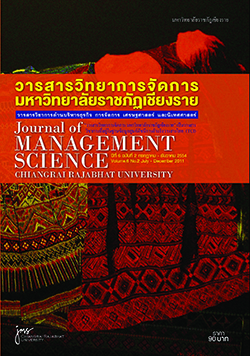Tourism and Income Distribution in Chiang Rai Province
Main Article Content
Abstract
The main purposes of the study entitled “Tourism and Income Distribution in Chiang Rai Province” were to (1) study the income distribution gaining from tourism in Chiang Rai (2) to examine factors affecting income distribution gaining from tourism in Chiang Rai . The study analysis was conducted by using Gini coefficient and Generalized Entropy index as inequality measurements together with applying the methods for decomposition of income inequality by source of income and regression-based inequality decomposition. The findings were as follows: The study of the income distribution gaining from tourism in Chiang Rai considering from the tourist expenses and household’s income related with the tourism, it was found that the households living in high potential of tourism area had the income inequality in a high level where as the households living in the low potential of tourism area had the income inequality in a low level. According to the decomposition of income inequality by the source of income, it showed that the tourism sector‘s income was increased by 1% and this resulted in the Gini Index of total income by 0.0451 where as non-tourism sector‘s income was increasingly changed into 1% and this resulted in the Gini Index of total income was reduced by 0.0517. The factors affecting income distribution gaining from tourism in Chiang Rai based on the Regression-based inequality decomposition, it was found that the household structure (household average education, household employment, and household dependency ratio) and household profession in tourism (agricultural profession and proportion of household profession in tourism) influenced the income inequality at 16.66 % and 5.30%, in respectively.
Article Details
Views and opinions expressed in the journal do not necessarily reflect those of the editors.


